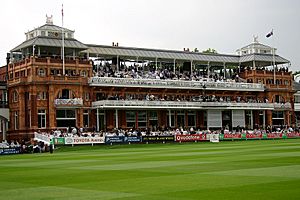Lord's Pavilion facts for kids
The Lord's Pavilion is a famous building at Lord's Cricket Ground in London, England. It's like the main clubhouse for cricket players and fans. Thomas Verity designed it, and it was built between 1889 and 1890. It's a very old and important building, recognized as a special heritage site. The Marylebone Cricket Club (MCC) owns it. It's also used by the Middlesex County Cricket Club and the England cricket team.
Contents
History of the Pavilion
The current pavilion opened in 1890. It cost about £21,000 to build. This was after the first pavilion was destroyed by a fire.
For a long time, until 1999, women were not allowed inside the pavilion as members during games. The only exception was Queen Elizabeth II. In 1998, the MCC decided to let women become members. This was a big step forward for the club and the pavilion. In 1986, Diana Edulji, who was captain of the India national women's cricket team, was not allowed in. She joked that the MCC should change its name!
In 2004, the pavilion had a big makeover. It cost £8.2 million. More seats were added on the upper levels. Famous areas like the Long Room were also updated and redecorated.
Only one batsman has ever hit a cricket ball over the top of the pavilion. This was Albert Trott in 1889. In 2010, Marcus Trescothick was offered £1 million to hit a six over the pavilion. That shows how hard it is to do!
Pavilion Rules
The rules for what to wear in the pavilion are very strict. Men must wear ties, tailored coats, and proper trousers with good shoes. Women need to wear dresses, or skirts or trousers with blouses, and appropriate shoes.
Pavilion Features
Dressing Rooms
The pavilion has special dressing rooms for the home team and the visiting team. Each dressing room has its own balcony. From here, players waiting to bat or other team members can watch the game.
Honours Boards
If a player scores a century (100 runs) or takes five wickets in a Test match, their name goes on the Lord's honours board. These boards are in the dressing rooms. English players' achievements are in the home dressing room. Players from other countries are in the away dressing room.
Many famous players, like Shane Warne, Sachin Tendulkar, Brian Lara, Ricky Ponting, and Curtly Ambrose, never got their names on the honours board. This shows how hard it is to achieve!
Long Room
The Long Room is a very special part of the Pavilion. People call it "The most evocative four walls in world cricket." It's a room players walk through on their way from the dressing rooms to the cricket field. The walk at Lord's is known for being long and a bit tricky. Once, in 1975, David Steele got lost and ended up in the basement toilets!
The Long Room has many paintings of famous cricketers and club leaders. These paintings are from the 1700s to today. Members of the MCC and their guests can go into the room. It has windows with great views of the ground. They often joke with Australian batsmen as they walk out to bat. Australian player Justin Langer said walking through the Long Room felt like "being bearhugged by an invisible spirit."
Sightscreens
The Lord's pavilion has four movable sightscreens. These screens move on wheels. They help batsmen see the ball better by providing a clear background. This is important because bowlers can bowl from different angles.


